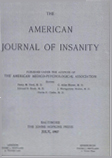SYPHILIS IN SERUM NEGATIVE FEEBLEMINDED CHILDREN
Abstract
If we consider sero-positive reactions in the feebleminded population as indication of congenital syphilis, the percentage of congenital syphilis is very low—less than 2 per cent. This estimate is, however, based on usually one test and it is known that this percentage is much too low. It is generally agreed that the sero- reactions in congenital syphilis vary to a great extent and tests must be repeated several times and qualitative tests ought to be used. If we consider those cases which are suggestive of syphilis, the percentage is much higher and would amount to almost 15 per cent of the patients. Various investigators have found various percentages. Most agree at the present time that a fair estimate would be between 7 per cent and 10 per cent.
Investigations under way at the Wrentham State School approach the problem from another angle. In microscopic studies of autopsy material, several alterations were found which strongly indicated congenital syphilis. The number of cases is still too small to dwell on any speculation about the percentage of these syphilitic cases in relation to the whole population.
The microscopic examination of two cases, studied on the basis of several hundred slides each, has been presented. The first case was an instance of vascular meningoencephalitis, associated with Heubner's arteritis and peri- and endarteritis gummosa. The second case was a case of the so-called Nissl-Alzheimer endarteritis- syphilitica of the small brain vessels. The sero-reactions in congenital syphilis were discussed in detail.
These cases have been presented to demonstrate the difficulties which are still outstanding in establishing the diagnosis of congenital syphilis. The discussion may stimulate clinical and pathologic studies of this type of children who represent rather a considerable percentage of the population in schools for the feeble- minded and may eventually lead to a definite understanding of the role played by congenital syphilis in the production of mental deficiency.
Access content
To read the fulltext, please use one of the options below to sign in or purchase access.- Personal login
- Institutional Login
- Sign in via OpenAthens
- Register for access
-
Please login/register if you wish to pair your device and check access availability.
Not a subscriber?
PsychiatryOnline subscription options offer access to the DSM-5 library, books, journals, CME, and patient resources. This all-in-one virtual library provides psychiatrists and mental health professionals with key resources for diagnosis, treatment, research, and professional development.
Need more help? PsychiatryOnline Customer Service may be reached by emailing [email protected] or by calling 800-368-5777 (in the U.S.) or 703-907-7322 (outside the U.S.).



